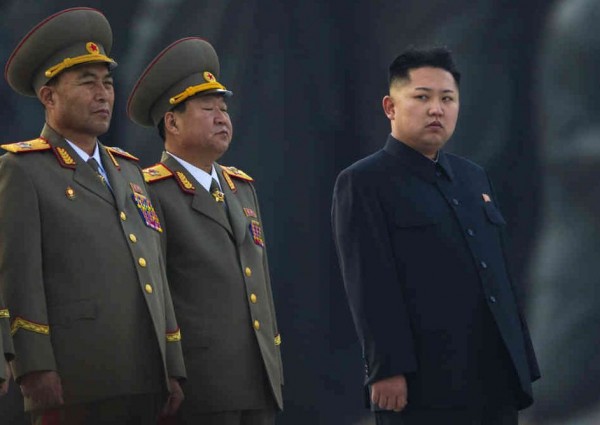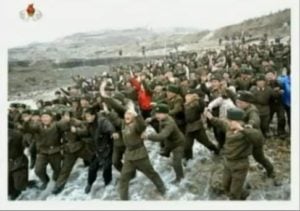
North Korean leader Kim Jong-un with two senior members of the military. Image: NPR
At first glance, the temperature on the Korean Peninsula appears to be tense but stable, and at a time when the United States is successfully concluding an annual military exercise with South Korea. Last week the U.S. publicly announced that strategic bombers — B-52s capable of launching nuclear weapons — would take part “in flight training in the Korean peninsula” as part of the joint U.S.-ROK exercises. International Crisis Group warns that “the threat of miscalculation and inadvertent escalation has risen considerably.” U.S. Secretary of Defense Chuck Hagel has announced that the United States over the next few years will add an additional 14 ground-based ballistic missile interceptors to the 30 already in place to bolster defenses against a possible North Korean (or Iranian) nuclear missile attack. (One could speculate that this move also has China in mind.)
There is a very long list of recent belligerent North Korean actions and rhetoric including: a long-range missile test last December, a third nuclear device test in February, threats of “pre-emptive” nuclear attacks upon the United States and South Korea, nulling of the Korean War armistice, a cyber-attack on South Korean banks and media outlets — the source as yet is not known, but for obvious reasons North Korea is a prime suspect.

Picture shown on North Korean state television of North Korean soldiers rushing to greet Kim Jong-un. Image: The Guardian
The missile launch and nuclear test have both been condemned by the U.N. Council Resolutions, indications that China — North Korea’s main trading partner — may be non-too pleased with its neighbor’s actions at a time when China is going through a leadership transition and involved in a territorial dispute with Japan. This all comes at a time when Ms. Park Geun-hye has just been inaugurated as president of South Korea, and the young and inexperienced (28-year old?) North Korean leader, Kim Jung-un, is continuing to try and solidify his power in a country that is arguably one of the most brutal suppressors of human rights in the world.
Why North Korea is doing what it is doing is very open to speculation. There have been recent reports of an assassination attempt upon Kim Jung-un. True or not, one thing surely is certain, the governing structure in North Korea is very brittle, not able to absorb sudden shocks or upheavals easily. Furthermore, Victor Cha, Korea Chair at CSIS, explains that North Korea “does a military provocation of some form within weeks of every South Korean presidential inauguration dating back to 1992.” President Park and her administration have made very clear that South Korea will not tolerate attacks from North Korea as in 2010 when the South Korean warship, the Cheonan, was sunk by a North Korean torpedo and the island of Yeonpyeong was hit by artillery shelling. In total, 50 South Korean lives were lost, including two civilians. In her inaugural speech, President Park highlighted “outstanding security challenges such as North Korea’s nuclear threat.” As alluded to above, there are some indications that China is unhappy with recent North Korean actions, but in the past China has been prepared to prop up the regime for reasons of “stability.” Time will tell if this will continue to be Chinese policy under President Xi Jinping.
David Sanger, in his book The Inheritance, is highly critical of President George W. Bush’s policy towards North Korea and its abject failure in preventing that country from acquiring a nuclear device. Last week, March 20, was the tenth anniversary of the beginning of the Iraq War, a war that was started on the premise that Iraq processed nuclear weapons. A claim that later turned out to be false. However, as Sanger explains, right next to Iraq, in Syria, the North Koreans were busy building a nuclear reactor which was later destroyed by Israel. Furthermore, it was under President Bush’s watch that North Korea actually developed and tested its own nuclear device in 2006.
Looking ahead to the short term, it is prudent to predict that any kinetic action by North Korea will be met by “a strong and decisive combined ROK-US response” as outlined in the March 22 ROK-U.S. Combined Counter-Provocation Plan. Hopefully this message is being clearly heard and understood in Pyongyang, a message that both the United States and South Korea have consistently and repeatedly conveyed to that regime.
Click here for footage of Kim Jong-un visiting military units near the South Korean border.
Damien Tomkins is Project Assistant at the East-West Center office in Washington, D.C. where he contributes research and content to the Asia Matters for America initiative and coordinates the Asia Pacific Bulletin publication series. The views expressed here are solely those of the author and not of any organization with which he is affiliated.